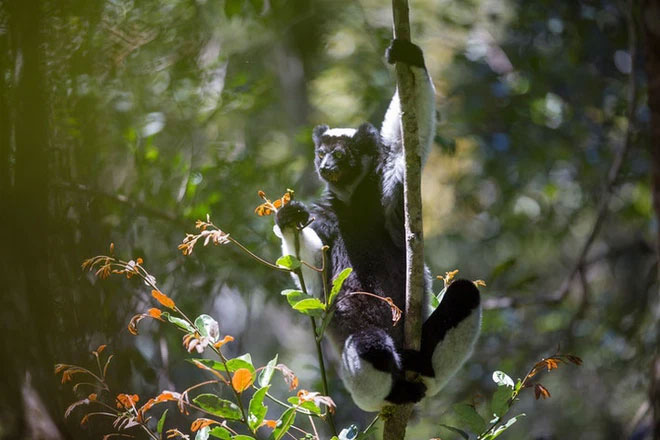The two words “rhythm” made researcher Chiara De Gregorio think of two things.
One, it is the famous melody of the song We Will Rock You by the legendary band Queen. *BOMP BOMP CLAP, BOMP BOMP CLAP*
Two, it is the Indri indri, a species of lemur that is on the brink of extinction, residing on the island nation of Madagascar.
De Gregorio’s research team has put in considerable effort studying the rhythmic abilities of this unique lemur species and recently published their findings in the journal Current Biology.

Freddie Mercury of the animal kingdom?
“In the two categories of rhythm present in the Indri indri, we find it closely resembles the intro of the song ‘We Will Rock You’ performed by the famous band Queen,” said De Gregorio, the lead author of the study. The catchy rhythms of We Will Rock You not only helped the iconic band Queen gain fame but also represent one of the unique forms of language among humans: rhythm.
According to the new research, the Indri indri is the only species (as of now) that accurately mimics the rhythm of the famous song. This new finding reveals an unprecedented connection between humans and the creatures living on this isolated island nation and opens up the possibility that other mammals may also perceive and enjoy catchy rhythms.
How the Research Team Made the Discovery
It may seem strange to travel to distant Madagascar specifically to study the Indri indri. However, considering that they are one of the few primate species capable of singing, the research team’s decision has a solid foundation.
The Indri indri, a successful resident of the island nation of Madagascar. At the 44th second, you can hear the “song” of the lemur.
The lemurs do not sing randomly; the melodies they produce have specific rhythmic breaks. This is a sign that the Indri indri perceives rhythm. “Rather than defining them as ‘music’, the unconditional rhythms can be used to signal time, emitted in the form of sound signals,” De Gregorio noted.
For instance, the ticking of a clock: we do not consider these regular beats as music; however, we still regard the regular, rhythmic breaks in the song We Will Rock You as music.
“Since the songs of the indri primates are composed of notes divided into segments, they serve as indicators to help us understand whether animals can comprehend unconditional rhythms like we do when listening to music,” De Gregorio said.
Scientists recorded the songs of the Indri indri as supporting evidence for the new research and measured the intervals between the notes using mathematical ratios. “We calculated the ratio of pauses between two notes by dividing each pause and adding the length of the next note,” the study’s author stated.
Notes with equal pauses will have a ratio of 1:1, similar to the way a clock ticks. But if one pause is half the length of another, with a ratio of 1:2, we will have a melody that is not uniform and monotonous.

Indri indri species.
The scientific report asserts that the 1:2 ratios demonstrate “the rare aspect of human-origin music in other animal species.” Discovering these unique ratios in the songs of the lemurs will significantly impact our understanding.
The research results confirm that the Indri indri is the first non-human mammal to exhibit rhythm. The irregular pauses between notes are similar to “the notes found in human music.”
Among the songs of the lemurs, the research team found two musical segments that perfectly matched the rhythm of We Will Rock You. This indicates that “the songs of the indri primates are even more special than expected,” De Gregorio noted.
Why This Research Is Special
No matter how different human culture and language may be, we all share a common language of rhythm. A good piece of music can make groups of people from all faiths, cultures, or ethnicities nod along to the melody. We can even unconsciously use our hands to mimic the rhythms we hear in real-time.
We have a talent for recognizing rhythm, which lays the groundwork for the invention of music.

An image that can produce sound, specifically the intro of “We Will Rock You”.
“Unconditional rhythms appear in the music of many different cultures, so they are a common standard of music,” researcher De Gregorio stated.
Until now, we thought we were the only species capable of creating unconditional rhythms to connect into melodies. But with this new discovery, researchers have taken a step closer to understanding the origins of music and the history of rhythm formation. According to De Gregorio, this is evidence that musical talent may have been part of the primate legacy.
The research also highlights the role of the Indri indri, a primate species at risk of extinction. Conservation efforts for this unique animal will thus become more resolute. This discovery can be compared to the whale conservation movement of the 1970s, when researchers used the musical abilities of whales to elevate public understanding.
“We hope this interesting discovery can make us more aware of the serious situation that the lemurs are facing,” De Gregorio concluded.


















































